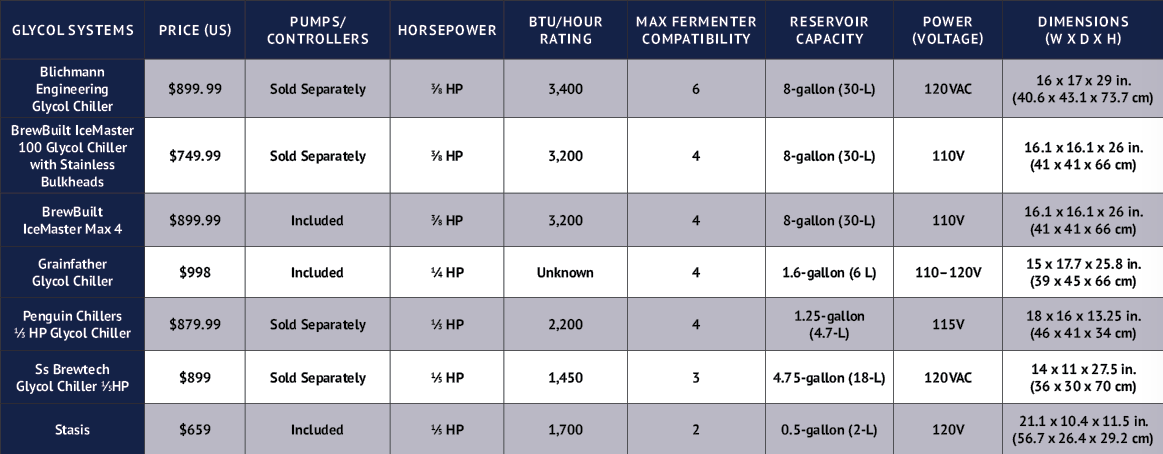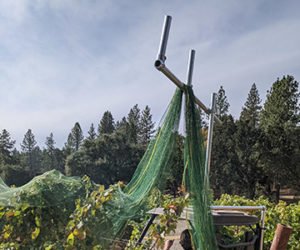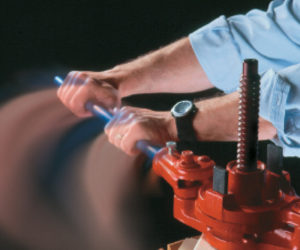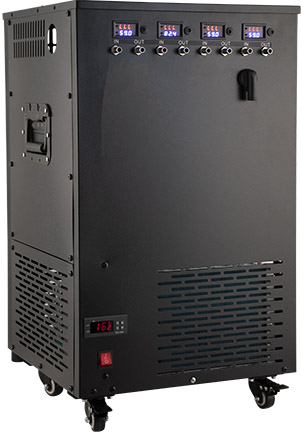
Glycol cooling systems have been fixtures in commercial wineries for many years. Often using large, permanently mounted refrigeration compressors, they circulate a chilled solution of propylene glycol through pipes arranged throughout the cellar. At each cooled tank, connections allow for the circulation of the chilled glycol through a jacket surrounding the wine or must. Digital controllers monitor the temperature in each tank, sometimes reporting to a central control booth that allows for remote adjustments.
I have long admired systems like these because I recognize that temperature control is one of the most important variables in making consistent, excellent wine at home. Like many home winemakers, I considered glycol systems to be out of reach due to size and cost. I have relied on the same variety of makeshift techniques I have talked with other home winemakers about. I put fermenters for white wines in my wine cellar with a through-the-wall cooling unit set at 55° F (13° C). I have used frozen jugs of water to cool a red must while the crushed grapes soak and my former business partner, Nancy Vineyard, routinely used dry ice while cold-soaking Pinot Noir must. In the winter, I open the cellar door to my white wines on freezing nights to try for cold stabilization.
All of these methods work, but they do not offer precise, automatic temperature control. In recent years, homebrewers have brought us home winemakers a whole new opportunity: Home winery-size glycol
cooling systems.
Just as with wine, fermentation temperature control is very important in making high-quality, consistent beer. Over the last couple of decades, some homebrewers have moved up from 5- or 10-gallon (19- or 38-L) batches to systems as large as 1 barrel (as a measurement, a beer barrel is 31 gallons, or 117 L, although beer is distributed in kegs typically containing a half barrel or less). Since the smallest of commercial brewing operations, sometimes called nanobreweries, begin at about the 1-barrel size, there is considerable crossover in equipment use between large-scale homebrewing and small-scale commercial brewing. Home-scale glycol systems represent that trend and there is no reason you can’t adapt one to your wine cellar as well.
WineMaker’s sister publication, Brew Your Own magazine, developed and published the table of available systems at the end of this article. So let’s literally borrow a page from the brewers’ book and look at home-size glycol system applications for home winemakers.
How they work
Besides being smaller than large commercial winery setups, home glycol systems are portable, often equipped with wheels for easy movement. The largest units in the table at the end of the article are no bigger than a two-drawer filing cabinet and several are smaller (dimensions are shown). All of them operate by maintaining a tank of propylene glycol/water solution at a set temperature with pumps to circulate the chilled coolant. In home units, the reservoir tank for the glycol solution is just a few gallons and power is applied by simply plugging into a household outlet. The chilled glycol, usually near 32 °F (0 °C), is pumped through flexible tubing to the tank or carboy you wish to chill. To control the fermenter temperature, a temperature sensor probe attached to an electronic controller is submerged in your wine or taped to the outside of the fermenter. To maintain sanitary conditions, you can use a stainless steel thermowell (a tube closed at one end) to contain the probe when it is placed in the wine. The controller automatically turns the pump on and off, circulating the glycol as needed to maintain your wine’s set point.
For each tank or carboy you want to cool, you need a separate pump and controller. As you can see from the table, all of these chiller models are capable of controlling more than one pump simultaneously. As noted there, for some systems you need to buy the pumps and controllers separately and others include pumps and controllers as sold. Each manufacturer provides estimates of the size and number of fermenters that can be cooled by the unit. Since they originate with the brewing industry, they may make reference to capacity for cold-crashing as well as capacity for fermentation. For us home winemakers, the cold-crashing capability is akin to cold stabilization and the cooling needs of active fermentation are like those in brewing beer. A larger glycol reservoir may provide steadier temperature control when working near the maximum capacity of the machine. The horsepower energy rating of the compressor is a rough guide to the cooling capacity and the BTU/hr rating is a widely used capacity reference figure in refrigeration of all kinds. A higher BTU/hr rating means higher heat removal — more chilling — from the refrigerator. For most efficiency in the cellar, providing a cool environment and insulation on tanks and carboys will help maximize your capacity.
Rods, Coils, and Jackets
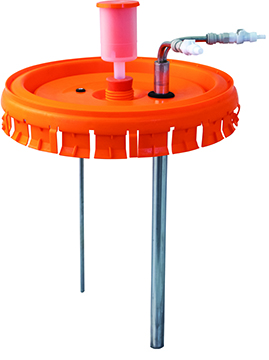
So how exactly do you utilize circulating chilled glycol in your wine cellar? There are three principle tools home winemakers can use to transfer heat from the wine to the glycol solution to hold a set temperature. These are a cooling rod, a cooling coil, or a jacketed tank.
For carboys and other narrow-mouth containers, a cooling rod is the best bet. The cooling rod — or actually tube — is made of stainless steel and is configured to circulate the chilled glycol in a closed loop throughout its length. You attach flexible tubing from your chiller pump’s “out” port to the inlet port of the cooling rod and another tube back to the chiller’s reservoir tank from the outlet port of the rod. Cooling rods are available in a variety of configurations, adding such features as valves, quick disconnects, and caps or stoppers to adapt to plastic or glass carboys. For example, BrewBuilt CoolStix™ are suited to carboys and other small fermenters at prices ranging from about $60–$150. Some stoppers for cooling rods are arranged to also accept a compatible stainless steel thermowell so you can extend the temperature probe down into the middle of the carboy.
Beyond carboys, you may want to cool an open-top fermenter (like a food-grade plastic trash can) or a bucket or non-jacketed tank. Several different designs of stainless steel cooling coils are available for these containers. For the simplest applications, you just connect your cooling hoses to the inlet and outlet of the coil and hang the coil in the tank.
If you want to use a cooling coil in a closed tank, it is a bit more complicated. There are brewing fermentation tanks on the market that feature a flat lid that can accommodate a cooling coil with bulkhead fittings making a seal. Ss Brewtech and Blichmann Engineering offer such stainless steel fermenters and cooling coils. If you already have a tank with a flat lid, you may be able to punch or drill holes in the lid that would allow you to retrofit a bulkhead fitting coil. Although designed with slightly different objectives in mind, the larger homebrew fermentation tanks should work well for wine, especially whites and rosés.
The systems most like those at commercial wineries use jacketed stainless steel tanks. A range of homebrew equipment suppliers, including several of the manufacturers of glycol systems, offer fermenters and bright tanks with built-in glycol circulation jackets. Most stainless steel beer fermenters are fitted with conical bottoms and drain valves and can utilize a fermentation airlock. They are available as small as five gallons (19 L), but jacketed models are usually 1⁄2 barrel (15.5 gallons/59 L) or larger. A bright tank is a secondary stainless steel tank in a brewery that receives filtered beer after fermentation is complete. They are pressure-capable; beer is often carbonated here and may be put directly on draft service. So although they are not variable in capacity, to use one for wine storage or aging you could flush the headspace with nitrogen or argon and hold it under pressure to prevent oxygen from entering. Do not use carbon dioxide for this application unless you want to carbonate your wine.
More familiar to most home winemakers are the cylindrical stainless steel variable capacity tanks with a “floating” lid held in place by an inflatable inner tube. They are available in sizes from 13 gallons (50 L) to 264 gallons (1,000 L) or more. Although most of these have historically been sold for home use without a jacket, the good news is that your home winemaking supplier can order almost any size factory-equipped with an integral stainless steel jacket. Order well before harvest season, since most of these come from Italy or Germany.
For any of the three options — rod, coil, or tank — you will need to make appropriate tubing connections to the pump from your glycol chiller. Either end of the system may be equipped with hose barbs, threaded pipe fittings, tri-clamp stainless steel beverage fittings, or other fixtures. Be sure to talk over the choices with your chiller dealer to make sure you have compatible fittings and correct tubing when it comes time to cool your must or wine.
Putting it to Use
And when is that time? Once you have a reliable cooling system, you may find yourself employing temperature control much more than when you had to rely on improvising. The first time your cooled tank may come into service each year is at crush. If you want to cold soak red must after crushing, you could drop a stainless steel coil into your usual fermentation bin, set the target temperature, and walk away. Be sure to come back and stir from time to time to keep the whole must cooled.
For settling white or rosé grape juice after pressing, a closed container is generally preferred. From the press, you could transfer the juice to a jacketed tank or to a carboy with a cooling rod and a sealed cap. After holding the juice at 41 to 50 °F (5 to 10 °C) overnight, you can rack off of the gross fruit lees and reset your controller to your desired yeast-pitching temperature of perhaps 55 to 65 °F (13 to 18 °C). Still using a closed container, you will now want to allow some headspace for foaming and you need to attach an airlock.
Beyond cold soaking reds and all the way through fermenting whites, you eventually get to the bulk aging stage for your wine. For any wine, the typical underground cellar temperature of 55 °F (13 °C) is considered ideal for aging. The temperature should be held constant during that time. In a jacketed tank or with a cooling rod in a barrel, you can set that temperature and not be so concerned about ambient temperature fluctuations. Even if you don’t have a controlled-temperature cellar, you can still have controlled-temperature wine in bulk with a glycol chiller. With a multi-pump system and cooling rods, you could keep several barrels on a rack at a constant 55 °F (13 °C).
Cold soaking the must and then holding bulk wine at cellar temperature are probably as far as you will use your glycol system in red wine production. For white and rosé, though, there are a couple more applications. One of these, cold stabilization, sometimes gives me trouble using improvised methods. Where I live in Sonoma County, California, we get a few multi-day periods every winter of nighttime temperatures below freezing — although not much below. If I have carboys or a tank of white or pink wine that is complete but not yet cold stabilized, I closely watch the weather forecast and open my cellar door each night that a freeze is predicted. I have to close the door early the next morning, since even in winter the daily high will be well above freezing. So for a few nights in a row, I try to chill the wine every night. Then we get a warming trend again and I have to just leave the cellar closed until the next cold spell. It is a cumbersome and unreliable method, but I don’t have a refrigerator big enough to handle my usual lot size, around 30 gallons (114 L) of any one wine. With a glycol chiller, I could set a target temperature of, say, 34 °F (1 °C) and cold stabilize as long as I want.
The final application with white wine is cold filtration. If you have already cold-stabilized a wine during cellar storage, you may hold it at a common cellar temperature like 55 °F (13 °C) for a few weeks of aging. If you want to bottle in the springtime while the aromas are still fresh and bright, there might remain some instability. The wine can be filtered just before bottling to assure complete clarity and you can add additional assurance by chilling before filtering. Since oxygen (and other gases) dissolves more readily in low temperature liquids, consider blanketing any cold filtration operation with nitrogen or argon.
So, is it worth it?
Now that you know what is available for home glycol chilling, you may be wondering why this makes sense in your cellar, and is it worth the cost? As you can see in the chart on the following page, these units have a price range that starts at $659. The answer to whether the investment is worth it will depend on each home winemaker’s personal situation — what they currently have in place to control temperature (and how well it is working), how much wine they make, how much use they will get out of it, space considerations, and their budget.
It’s undeniable, there are serious benefits to these units. First, compared to improvised approaches to cooling, the glycol chiller is very efficient and reliable. You set and forget it (well, don’t get that casual, but it is automatically controlled). Second, the systems are much more compact than trying to have enough chilled refrigerator space to store your wine for cold soaking or cold stabilization. On a related note, you do not have to consider any sort of construction or remodeling in your cellar to implement this cooling system — it is plug-and-play. Do give some consideration to placement, though, as you will have coolant hoses and probe cables arranged between your chiller and your wines. The final reason I would give for considering one of these systems: They are now available. We, as home winemakers, can thank the homebrewing community for bringing us a resource most of us have never considered for our little wineries.
